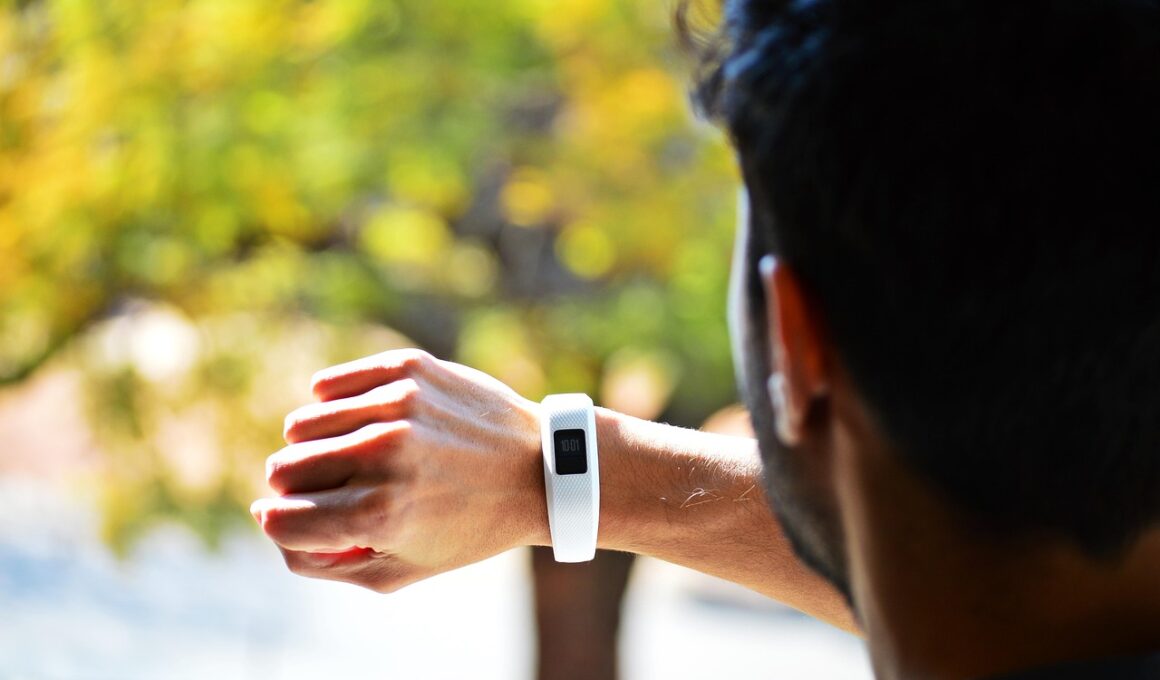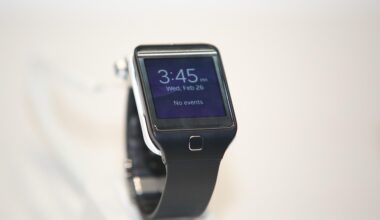Benefits of Pairing Fitness Progress Tracking with Sleep Monitoring
Tracking your fitness progress is crucial for achieving health goals, allowing for measurement of performance improvements. Integrating sleep monitoring enhances this process significantly. Quality sleep has been linked to recovery and improved physical performance. When combined with fitness tracking, users gain a comprehensive view of their health data. This merger aids in adjusting workout regimes to optimize outcomes. Moreover, tracking sleep can help identify trends correlating to performance metrics, such as endurance or strength. Sleep disturbances can impede recovery, thus recognizing them can prompt timely adjustments. Using wearables or apps facilitates easier data compilation. By aligning both metrics, individuals can act on informed insights tailored to their needs. As a result, users experience practical solutions rather than trial and error methods. Enhanced motivation arises when progress is vividly tracked, empowering individuals to adhere to their routines. With clear visibility on factors affecting performance, individuals can make educated decisions regarding their lifestyle. Such integrations efficiently guide users to pinpoint areas needing change, whether it’s sleep hygiene or exercise frequency, increasing overall fitness efficacy.
Effective fitness tracking tools often include both activity logs and biometric feedback. However, without considering sleep quality, those insights may be incomplete. When engaging in daily workout sessions, your body’s ability to recover hinges on adequate rest. Aligning fitness regimes with sleep data not only improves recovery but also amplifies performance. Data-driven insights can inform adjustments to one’s routine, making fitness sustainability achievable. Additionally, understanding the sleep-progress interaction illustrates how fatigue impacts motivating factors within one’s journey. Individuals might embrace structured plans better when cognitive functionality is at its peak. Tools that visualize both exercise and rest contribute to long-term success and healthier behaviors. By building a sleep-friendly routine, individuals can find themselves more energized for workouts. Over time, such tracking creates a symbiotic relationship between physical effort and restorative sleep. Engaging fitness communities can share strategies that further enhance accountability. This exchange of experience facilitates shared learning, enriching each individual’s understanding. Collectively tracking both metrics leads to improved outcomes, reinforcing the notion that monitoring leads to better health decisions and fruitful results.
The Synergy Between Sleep and Fitness Progress
Synergizing sleep monitoring and fitness tracking unveils insights often overlooked. Sleep influences metabolism, hormone regulation, and muscle repair. Hence, improved sleep can naturally lead to enhanced workout results. Various studies highlight how poor sleep patterns correlate with weight gain and performance declines. Thus, pairing these two data points presents opportunities to tailor fitness journeys effectively. Individuals can experience heightened energy levels post-restful sleep, directly translating to improved performance metrics. For many, this realization promotes a more intentional approach toward both health aspects. Sleep aids recovery during intense training phases, while fitness activities can often lead to restless nights if improper mechanisms are applied. By logging both exercises and sleep, users can break negative cycles and intervene proactively. Recognizing sleep patterns can help recognize when fatigue is setting in, prompting adjustments before burnout occurs. This dual monitoring allows for more comprehensive behavioral adjustments over time. Community initiatives can foster support and encouragement for users implementing these changes. By sharing experiences, individuals cultivate resilience and productivity, cultivating a collective understanding of health approaches that yield tangible results.
Cognitive function significantly benefits from adequate rest, influencing motivation levels and workout performance. Logically, a fitter individual with quality sleep tends to perform better in workouts, maximizing time spent exercising. Sleep also helps regulate hormone levels that are crucial for energy and recovery. For example, individuals may notice a decline in cortisol and increase in testosterone after consistent quality sleep. These changes enhance body composition, recovery times, and overall performance. Hence, tools and apps that track both aspects offer insights that help fine-tune fitness approaches. Patterns may emerge from data, suggesting better days for intense workouts when well-rested. Adaptations to routines can then be made; for example, scheduling tougher exercises on weekends after good sleep. On the flip side, inadequate sleep may indicate less intense workout days or rest periods. By embracing the interconnected nature of these variables, individuals can achieve a more well-rounded and effective fitness journey. Engaging with fitness communities about shared experiences often reinforces positive changes, further fostering an environment focused on holistic development and wellness.
Conclusion: Creating a Holistic Fitness Strategy
Creating an inclusive and holistic fitness strategy requires awareness of the synergy between sleep and exercise. When individuals track both effectively, they unlock the potential for enhanced physical performance alongside restorative practices. This dual approach not only leads to noticeable progress in fitness goals but also improves overall wellbeing. Greater awareness and diligent monitoring encourage individuals to adopt healthier routines, mitigating negative behaviors over time. Joining a fitness community can provide encouragement; members often motivate and inspire one another through shared accountability. As discussions unfold, strategies can emerge on optimizing both sleep hygiene and workout effectiveness. Such exchanges enable individuals to gain insights from one another’s experiences and learned practices. Continuous feedback loops offer immense potential for growth as users fine-tune their behaviors toward achieving their health aspirations. The understanding of how both elements interact can reshape individuals’ approach to fitness, pushing them toward full adoption. Additionally, making use of technology allows for streamlined tracking, translating into actionable insights that facilitate ongoing progress. Ultimately, those committed to both ends of the spectrum are likely to see substantial improvements, leading to enriched lives.
As users investigate the relationship between sleep and fitness tracking, they can leverage various resources available. Engaging in forums or reading materials helps contextualize findings, forming a personal guide to navigate their journey. Furthermore, professional guidance could provide tailored practices to address individual needs. Involving experts may enhance understanding of how sleep deficiencies can stall progress. Participating actively in supportive communities enables users to exchange tested results, generating consensus around effective tactics. A plethora of apps and devices exist that enable users to seamlessly track both components in real-time. Both fitness trackers and sleep monitors place valuable data at an individual’s fingertips, amplifying their understanding of personal health realms. By recognizing correlations, they can make informed decisions, positioning themselves to succeed. Such solutions allow individuals to break barriers and achieve lasting results through informed decisions based on carefully gathered metrics. Ultimately, this integrated approach can inspire new standards in fitness practices, reinforcing the importance of actively monitoring sleep and fitness simultaneously for a truly health-conscious lifestyle.
Pairing fitness progress tracking with sleep monitoring has been proven to yield incredible benefits in performance and recovery. Users can harness the power of real-time data to make informed decisions that propel their fitness journey forward. Health and fitness encompass more than just physical training; therefore, understanding all facets of well-being is vital. Such an approach nurtures a well-rounded lifestyle that values both activity and rest. As individuals gain insights into their personal metrics, they can embrace changes optimizing their regimes to meet unique needs. Ongoing tracking results in a feedback culture, where adjustments are made based on what’s learned. This mentality cultivates resilience and mindfulness in the community, driving a proactive approach to overall health. Moreover, bringing awareness to how sleep directly influences exercise performance can inspire effective habits in others. The results can lead to widespread adoption of best practices, reinforcing a culture of support within fitness communities. Ultimately, the merging of these two essential elements leads to improved outcomes and enriched lives, as individuals adhere to routines that honor their well-being holistically.
To optimize overall health and fitness success, individuals are encouraged to document their journey continuously. By recording reflections on progress, motivators, or obstacles they encounter, users can better understand the emotional facets associated with fitness routines. This practice can serve to deepen their engagement with both sleep quality and fitness activities. Furthermore, sharing these reflections with a supportive community amplifies accountability and encouragement. Individuals rallying together create an atmosphere rich with support, sparking motivation through collective experiences. Ultimately, the journey taken toward greater health becomes not only a personal endeavor but a shared experience that strengthens bonds within distinct fitness communities. Therefore, as fitness progress tracking integrates with sleep monitoring, individuals can perceive their journeys in a new holistic context. Together, these approaches promise enhanced performance levels, recovery strategies, and an overall improved quality of life. Indeed, awareness of these connections emphasizes the critical relationship between rest and activity, reinforcing the decision to monitor both closely. It is through embracing these aspects that optimal results are achieved, leading individuals to a sustainable path that thrives on progress.


